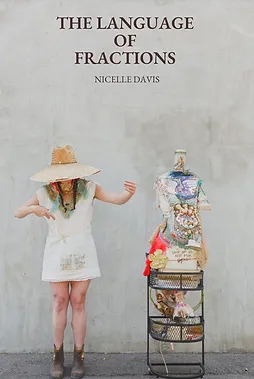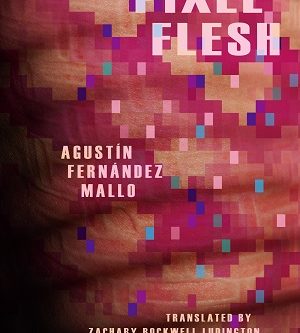
Poetry Collection by Nicelle Davis
Review by John Venegas
“Deconstruction” is a word that gets thrown around a lot, both inside and outside academic settings. At the risk of being reductive, it is the practice of taking something apart conceptually. This can be done with anything and its purpose is to understand how that anything functions. Breaking something down into its constituent parts, seeing how those parts fit together and/or function on their own, can be an enlightening and rewarding experience. There is argument to be made that such a process is how we learn in the first place. Unfortunately, the term and the process are all too often co-opted by disingenuous pseudo-intellectuals who try to reframe the concept as an intentionally constructed threat to “traditional values”, or use it to legitimize conspiratorial bigotry. But even setting aside that kind of cruel misuse, I think those of us with “good intentions” have a very consistent habit of missing the forest for the trees. Deconstruction is not done in a vacuum, and those who do it are neither dispassionate nor objective. We cannot observe or describe without affecting, and being affected. I think Nicelle Davis understands this on a fundamental, intimate level. In fact, I think The Language of Fractions is one of the purest examples and examinations of deconstruction that I have read. It is a collection of poetry that speaks to the necessity of the practice while also exposing the cost of such an endeavor, if you pursue it to any depth of significance.
He realized most makeup is designed to look like blood and bruises.
To get it out of the way, allow me to state my general thoughts on this collection in a single sentence: Davis uses an intoxicating combination of sublime intimacy and Cronenberg-ian body horror to rebuild the Tower of Babel as a beacon of community and a direct, open challenge to any power that would deny our inherent divinity.
What became of the heel? / What becomes of the toes? / What do you see in the red / Rorschach test of severed women’s parts?
It is no great observation to state that intimacy requires vulnerability, or that vulnerability can be frightening. But there is more beneath that surface, and Davis is not content to see us wet only our toes. Her poetry here forces us to acknowledge that to be deconstructed is to be taken apart, to have your pieces examined by eyes that you can only hope do not mean you harm. Many, many people have the lived experience of being taken apart (conceptually or physically) by the cruel and the unjust, who often have “altruistic” justifications. Those experiences, of being valued only for your cuts of meat or your bone structure or your fatty tissue or your capacity to breed more livestock, can sear themselves into the mind, onto the soul, assuming they don’t kill you outright. Their lingering legacy is forced disassociation, an effort to torture dissonant mental voices into screaming over your natural one and leave you confused and in a state of self-loathing.
You too can be a house, just make a list of who lives inside you – you haunted house – you open door – you a slowly closing uterus, you casket.
This is why I think Davis speaks to the clavicle and the humerus and the navel and all sorts of other body parts. She is trying to work backward, piece together a shared history and ancestral language. She can see the outline of the identity that was and, while she knows it can never be reconstructed as it had been, the potential for something new and greater awaits. This is a beautiful purpose, to be sure, but it is also the source of the horrifying constructs along the way. Understanding and repurposing require experimentation, require putting things together in ways that were not originally intended, no matter how much it might upset a tradition-laden mind. Moreover, there is no small amount of frustration, as pieces who have long since had individualism forced on them must come together, communicate, and co-exist.
Where do thousands of people go when real / estate agents put on a pub crawl?
Maybe the most telling aspect of the poetry is the consistent underlying tone. There is no shortage of grief, of fear, of regret, but through and beneath it all there is an essence of fascination. There is a relentless need to understand, a joy in the power of unorthodox creation, and a determination to connect with others through shared experience. Each section of the text is framed by a “Belly Poem”, literal navel gazing as if the speaker is repeatedly reaching into some kind of genetic memory to experience umbilical attachment. Is there anything more intimate than the sharing of blood? Than the blurring of the lines between what distinguishes two organisms from one another? Davis is a mad scientist, a mother, and trying to become her own beautiful emergent monster. She writes and rewrites rules and maps, creates games and writes to children to harness naiveté’s objectivity, and build collages out of images, advertisements, and pictures. There is an impulse, as a reader, to beg her to stop, to slow down, to dismiss her words and actions as feverish. But those are the efforts of a complacent mind trying to shield itself from realizing that it can begin to see what she sees.
If this was tarot, we would call it / divination, / but since it’s just a game, we call it the News. Think about how / the dinosaurs died – now make a wish upon a shooting –
And what she sees, among many things, is the inversion; the scar-pattern from how our perspectives were abused into something that someone else approved of. Seeing the rest of the world in horror is the first step, necessary to lance the infectious deception, but never the end goal. The goal is to have the capacity to see beauty for ourselves, in ourselves, and in each other. To this end, the poetry is serenely beautiful, elegantly crafted, and effortlessly witty. It is as if the dissonant and natural voices have stumbled upon a mutual train of thought and are beginning to realize how wondrous it can be when they sing together. To be clear, that beauty is thoroughly painted with loss, in memory of and gratitude for those who came before, and in regret for those who will not see. But without those colors, would the beauty even be real? The power of this collection lies in its visceral biological colors, in its appreciation of what was and what could be, and in a brilliant gaze that has forgotten how to flinch.
The Language of Fractions is available through Moon Tide Press.



